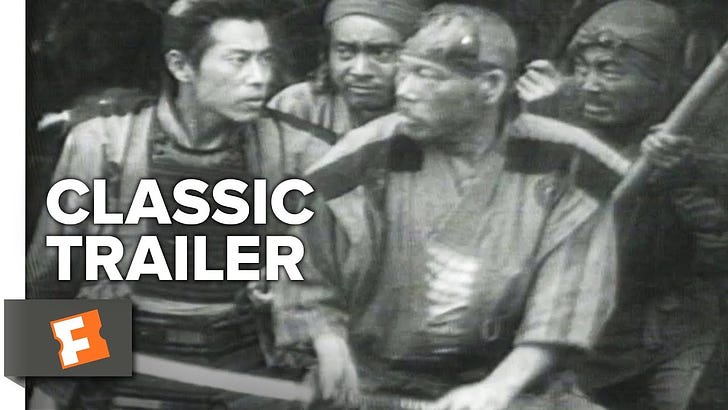10 Japanese directors to know to impress your Tinder date
Japanese cinema is fascinating. On the one hand, it's familiar and accessible enough to not alienate its western audience — anime and samurai are, indeed, already staples of pop culture. On the other hand, the cultural and esthetical differences are still meaningful enough to create compelling experiences.
Instead of browsing Netflix tonight, why not explore the filmography of some of the Land of the Rising Sun's best?
1. Akira Kurosawa
Let's get this one out of the way. The master. The one who introduced Japanese cinema to the international scene. His work is so distinctive and influential that there's a whole Wikipedia page called: "Filmmaking technique of Akira Kurosawa." He's perfected the art of chambara (samurai movies), but he could master any genre with an exceptional capacity to analyze humanity, both good and bad.
Three movies to watch:
Seven Samurai (1954)
Ran (1985)
High and Low (1963)
2. Masaki Kobayashi
There are many similarities between Kobayashi and Kurosawa. So much so that I'm actually surprised that they were neither rivals nor great friends. Their ability to move from samurai films to essays on the human condition is impressive, and it's crazy to think they were both releasing masterpiece after masterpiece in the 50s and 60s. To me, the main difference between the two is that Kurosawa was the optimistic one, his movies always carrying a humanist tone, while Kobayashi was the pessimistic one. Most of his work is about war and its impact on the human psyche.
Three movies to watch
Harakiri (1962)
The Human Condition trilogy (1959-1961)
Samurai Rebellion (1967)
3. Yasujiro Ozu
Why was the 50s such a prolific period for Japanese masterpieces? Perhaps the aftermath of the war raised important questions about humanity, love, and sacrifice. Perhaps destructive impulses gave way to creative impulses. Ozu is another great example of this. He didn't have the range of the two mentioned before him, but his groundbreaking and unconventional approach to filmmaking allowed him to transcend the nature of everyday topics.
Three movies to watch
Tokyo Story (1953)
Late Spring (1949)
Tokyo Twilight (1957)
4. Hayao Miyazaki
It's almost a meme at this point, but Studio Ghibli movies are really that good. Beyond his absolutely magical world-building, I appreciate that Miyazaki can make children's movies that are never formulaic, contrary to most western animation (ahem... Disney). Indeed, his characters don't need to resort to violence or confrontation to solve their problems. Instead, it's all about meditation and contemplation of nature. It's no surprise that Miyazaki is such an environmentalist.
Three movies to watch
Spirited Away
Princess Mononoke
My Neighbor Totoro
5. Takeshi Kitano
You probably know his face, because he's also a prolific actor. He may for example haunt your dreams as the sadistic teacher in Battle Royale. Little less known is that he's also a very talented director, capable of making anything from yakuza movies to road comedies, while always leaving some room for sentimentality.
Three movies to watch
Hana-bi (1997)
Sonatine (1993)
Kikujiro (1999)
6. Hideaki Anno
A director can rarely do both animation and live-action. Even rarer when this director's animation is revered as one of the finest works of Japanese culture. Quoting Wikipedia here: "His style is defined by his postmodernist approach and the extensive portrayal of characters' thoughts and emotions, often through unconventional scenes presenting the mental deconstruction of those characters."
Three movies to watch
The End of Evangelion (1997) (Please watch the show first, you'll be very confused otherwise.)
Ritual (2000)
Love & Pop (1998)
7. Sion Sono
The weirdo of the group. Some directors mentioned here dabble with postmodernism, but Sono takes it to a whole other, absurd, level. His masterpiece, Love Exposure, illustrates that perfectly. It is a 237-minute-long epic about "a teenage boy called Yu, who falls for Yoko, a girl he runs into while working as an 'up-skirt' photographer in an offshoot of the porn industry. His attempts to woo her are complicated by a spot of cross-dressing - which convinces Yoko that she is lesbian - dalliances with kung-fu and crime, and a constant struggle with the guilt that's a legacy of his Catholic upbringing." Love Exposure is absolutely ridiculous; and yet, it's still poignant, beautiful, and human.
Three movies to watch
Love Exposure (2008)
Red Post on Escher Street (2020)
Why Don't You Play in Hell? (2013)
8. Hirokazu Kore-eda
I think Kore-eda is the true successor of Yasujiro Ozu. Their movies, although separated by 50 years, carry the same vibes. Family is central to their work, along with a contemplation of everyday scenes, making the ordinary captivating.
Three movies to watch
Still Walking (2008)
Nobody Knows (2004)
Shoplifters (2018)
9. Satoshi Kon
Kon was one of Japan's best animators. Although his career was quite short, his four movies have had a lasting impact on Japanese and western directors. Inception, Black Swan, or Requiem for a Dream all have been influenced by Kon's work. Fascinated by the human psyche, especially Jungian psychology, Satoshi Kon's movies explore the frontier between reality and fiction. In Perfect Blue, for example, Mima, a novice actress, finds it increasingly difficult to tell the difference between the scenes in the film and her real life. Kon died from pancreatic cancer in 2010, at 46.
Three movies to watch
Perfect Blue (1997)
Millenium Actress (2001)
Tokyo Godfathers (2003)
10. Ryusuke Hamaguchi
Finally, this is probably the one to be the most excited about right now. Hamaguchi released two (!) of the best movies of 2021, collecting many awards on the way, including Best Screenplay at Cannes and a Golden Globe for Best Non-English Picture. His next movie, Our Apprenticeship, is set to release later in 2022, and you probably won't want to miss it.
Three movies to watch
Drive my Car (2021)
Happy Hour (2015)
Wheel of Fortune and Fantasy (2021)



